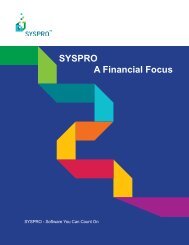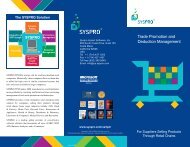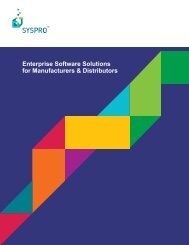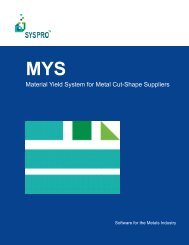Teach Yourself e.net - Syspro
Teach Yourself e.net - Syspro
Teach Yourself e.net - Syspro
Create successful ePaper yourself
Turn your PDF publications into a flip-book with our unique Google optimized e-Paper software.
Defining e.<strong>net</strong> solutions<br />
2.6. .NET and e.<strong>net</strong> solutions<br />
Although the name 'e.<strong>net</strong>' implies a close connection between the system and the .NET<br />
Framework, we cannot assume that everyone knows what .NET is and what the<br />
relationship between .NET and the SYSPRO system is. In this section of the introduction<br />
we will briefly discuss what .NET is and what the major components are. In the next<br />
section we will examine the relationship between the SYSPRO system and .NET through<br />
e.<strong>net</strong> solutions.<br />
2.6.1. What is .NET<br />
For many people learning e.<strong>net</strong> solutions, one of the most pressing questions at this<br />
juncture may be "What is .NET". The simplest answer is: “.NET is a Framework in<br />
which Windows applications may be developed and run”. I agree that this answer does not<br />
tell much, as true a definition as it is. In order to truly understand .NET we must go back<br />
in time and follow the development of Windows and the advent of Windows<br />
programming.<br />
The historical framework and working definitions of .NET used in this section are based<br />
on the information presented in the codeproject<br />
[http://www.codeproject.com/dot<strong>net</strong>/dot<strong>net</strong>.asp] introductory article on .NET written by<br />
Kashif Manzoor.<br />
2.6.1.1. The Road to .NET<br />
The Windows operating system provides programmers with various functions - called API<br />
(Application Programming Interfaces). Starting from the earliest version of Windows on<br />
the commercial market to the most recent version of WindowsXP, APIs are the basic tools<br />
that let the operating system know what you want it to do. If you want to create a Dialog<br />
Box you need to call a specific API provided by Windows. Creating a button requires<br />
another API call. And so the list goes on. As new and updated GUIs appeared on the<br />
scene, new APIs were introduced in Windows. But using these native APIs became a very<br />
challenging task. Making a simple Window that prints "Hello World" could take more<br />
than hundred lines of code. Compare this to the 5 lines of a "Hello World" program in<br />
DOS. Due to this difficulty, Windows programming was considered something better left<br />
to the experts. Microsoft and other commercial organization's were aware of this trend,<br />
and started marketing Visual Tools that made the programmer's life easier. Using Visual<br />
C++, Visual Basic, Borland's C++ and other such IDEs, it became much simpler to make<br />
Windows programs.<br />
Microsoft also realized that applications needed a solid way to talk to each other. This<br />
realization resulted in the introduction of Object Linking and Embedding (OLE). OLE was<br />
an extremely useful concept, but it had two major flaws : it was notoriously difficult to<br />
program, and it was very limited in its scope - i.e. it only did a few things like drag and<br />
drop, clipboard sharing, OLE client, OLE server, etc. Microsoft addressed (or at least tried<br />
to address) both of these problems. They upgraded OLE to COM. COM was much more<br />
2–9










